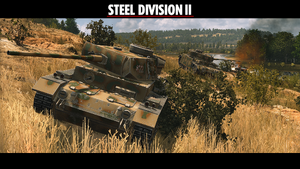
The Panzerkampfwagen III, commonly known as the Panzer III, was a medium tank developed in the 1930s by Germany, and was used extensively in World War II. The official German ordnance designation was Sd.Kfz. 141. It was intended to fight other armoured fighting vehicles and serve alongside and support similar Panzer IV which was originally designed for infantry support. Production of the Panzer III ceased in 1943. Nevertheless, the Panzer III's capable chassis provided hulls for the Sturmgeschütz III assault gun until the end of the war.
Background[ | ]
The Panzer III was developed in the 1930s, as part of the new German armored combat doctrine. Intended for fighting enemy tanks and infantry, the new tank entered production in 1936. Designed by Daimler-Benz, it was a traditional German tank, with heavily angled surfaces, a boxy superstructure, and a front-mounted gearbox. The first four variants, Ausf. A through D, were iterative developments that helped German engineers eliminate flaws in the design and iterate on technologies necessary for its production, with the first mature variant being the Ausf E, introduced in 1939. Initially adequate for fighting enemy tanks, Panzer III was replaced by its big brother, Panzer IV, in its tank-fighting rule as the limitations of its design became apparent.
Model[ | ]
Ausf. G[ | ]
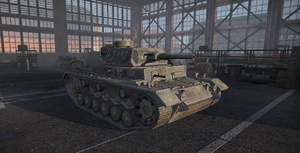
The Ausf. G entered production in April 1940 and lasted until February 1941, with 600 produced. Ausf. G iterated on the design, with a lengthened turret, increased rear armor (to 30mm), and a redesigned driver's visor. Panzer IIIGs mounted the 5 cm KwK 38 L/42 tank gun, with only a few still outfitted with the antiquated 3,7 cm KwK 36 L/46. Interestingly, Ausf. G was produced alongside Ausf. H, rather than preceding it.
Ausf. H[ | ]
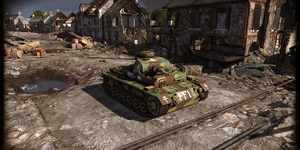
The Ausführung H was introduced alongside Ausf. G in October 1940, mounting the 5 cm KwK 38 L/42 (upgraded to the KwK 39 L/60 in 1942/1943) and applique armor by default, bringing the total thickness of its frontal armor to 60mm. The rear wall of the turret was also thickened to 50mm. Other modifications included a more reliable Maybach SSG 77 gearbox (replacing the old Variotex), new tracks and wheels. A total of 308 Panzer IIIH tanks were built, making it the shortest series in the Panzer III family, outside pre-production runs.
- Panzer III H: The basic variant.
- FFI Panzer III H: Captured Panzer III available to Demi-Brigade SAS
- Panzer III H Füh.: A platoon commander's tank.
- Bef. Panzer III H (SD2):The command tank variant of the Panzer III H still mounts the shorter, weaker 50mm gun of the H series, and is overall an older, inferior design of the Panzer III, predating the Ausf. J redesign.
Ausf. L[ | ]
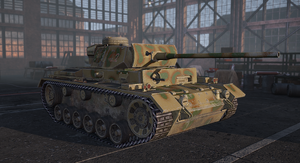
Panzer III Ausf. L built on the design of Ausf. J/1. The modern 5 cm KwK 39 L/60 introduced by the J/1 was made standard in this variant. The tank's armor was also improved, including the elimination of weak points such as hatches and visors on the sides of the turret. Starting in June 1942, a total of 653 Panzer IIILs were produced.
By 1944, the Panzer III was an outdated design that was a light tank by all accounts. Units that weren't converted into StuGs were sent to tank schools as training vehicles. Their unlikely appearance in Normandy was the result of 116. Panzer commandeering their training tanks, in order to fill gaps in their arsenal.
Ausf. M[ | ]
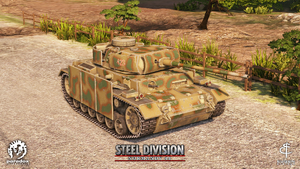
Panzer III Ausf. M was the penultimate variant of the Panzer III, produced from October 1942 to January 1943. Panzer III Ms were modified to allow fording streams up to 130 cm deep, equipped with a pair of triple-barreled smoke launchers (90mm NbKs), and mounted the standard 5 cm KwK 39 L/60 tank gun. Schurzen (side screens) were retrofitted on M panzers from March 1943 onward. Only 250 tanks of this series were produced, as Hitler ordered the production to cease, in favor of StuGs and the casemate-mounted 75mm tank guns, ideal for fighting Soviet tanks.
By 1944, the Panzer III was an outdated design that was a light tank by all accounts. Units that weren't converted into StuGs were sent to tank schools as training vehicles. Their unlikely appearance in Normandy was the result of 116. Panzer commandeering their training tanks, in order to fill gaps in their arsenal.
- Panzer III M: The basic variant of the tank.
- Aufk.Panzer III M
Ausf. N[ | ]
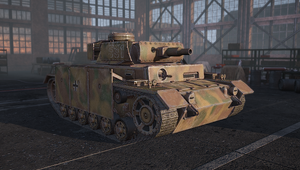
Ausf. N was the last variant of Panzer III, and an unusual one. Produced between June 1942 and August 1943, it used hulls manufactured for the J, L, and M variants, mating them to surplus 7,5 cm KwK 37 L/24 short-barreled tank guns left after existing Panzer IV tanks (Ausf. A through F1) were upgunned with long-barreled 75mm guns, taking over Panzer III's intended role. Panzer IIINs were used for fire support and close defense of larger, less mobile tanks like the Tiger. A total of 663 Panzer IIIs were converted to the N standard.
Conversions[ | ]
Muniwagen[ | ]
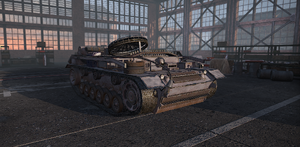
A field conversion achieved by removing the Panzer III's turret and using the vehicle as an all-terrain supply vehicle and prime mover.
Ausf. K[ | ]
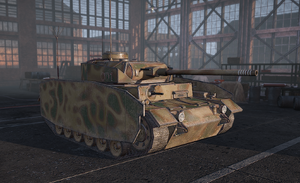
A customized Panzer III, Ausf. K was not a distinct series, but a conversion of an Ausf. J, L, or M tank. Fitted with more compact and simultaneously more powerful radios, the Ausf. K could be used as a Panzerbefehlswagen or command tank while retaining its 50mm tank gun. Some 300 conversions were made and sent to the Eastern Front between 1942 and 1943.
- Bef. Panzer III K: A battalion commander's tank.
SU-76i[ | ]
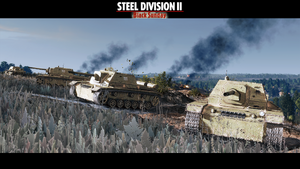
Surviving Su-76i advancing in Romania.
A large number of Panzer III tanks and StuG III assault guns was captured after the Battle of Stalingrad. As the vehicles were in good shape, the Red Army elected to recycle them to fill out its depleted inventory of armored fighting vehicles. Two hundred vehicles were sent to Factory No. 37 at Sverdlovsk for conversion. The original suspension and Maybach engine were retained, but the main weapons were replaced by an S-1 76.2mm tank gun mounted in a casemate on top of the vehicle. Several modifications were added to help the vehicle survive the harsh winters and make them more comfortable for Soviet tankers.
The conversions began arriving in frontline units in autumn of 1943, designated SU-76i (innostraya, foreign), 181 regular vehicles and 20 command variants. They performed well and were well-liked by their crews, and several surviving vehicles were retained for training purposes after the conversions were replaced by purpose-built casemated tank destroyers and guns. Retaining these vehicles is notable, as most captured equipment was immediately sent for scrapping once it broke down.
- SU-76i
- SU-76i Komroti: Platoon leader's tank.
Sturmgeschütz III[ | ]
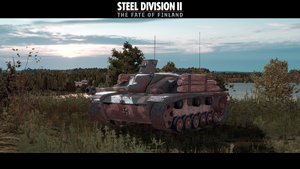
Sturmgeschütz III was one of the most successful Nazi designs, both in terms of units produced - ca. 10 086 StuG III- and the number of kills. The G variant was the most numerous, with nearly 8 500 manufactured or converted from previous variants. Several StuGs remained in use in Arab countries as late as 1967, used against Israel in the Six-Day War.
The StuG III began its life as a fire support vehicle, intended to provide infantry units with direct fire support against enemy fortifications and armored units. Daimler-Benz was contracted to create such a weapon in 1936, with the first production units rolling off the assembly line in 1940. Mounting the short-barreled 75 mm StuK 37L/24 gun in a casemate-style hull mounted on the Panzer IIIF chassis, they debuted during the Battle of France. Subsequent iterations of the series, Ausf. B through E, focused on improving mechanical reliability and resilience, without altering its combat role.
StuG III Ausf. E[ | ]
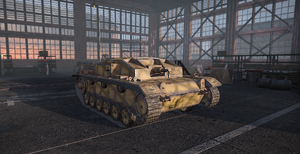
A StuG III E.
The Ausf. E was produced between September 1941 and February 1942, with a total of 284 units rolling off the assembly lines. The modifications in this model included additional space for radio equipment and extra space for ammunition.
StuG III Ausf. F[ | ]
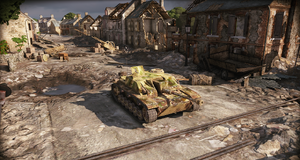
Everything changed with Ausf. F, which mounted the 7.5 cm StuK 40 L/43 and boasted thickened frontal armor, to allow it to effectively counter superior Soviet armored vehicles. From June 1942, the lengthened 7.5 cm StuK 40 L/48 was used.
- StuG III F Füh.: A platoon commander's tank.
- Bef. StuG III F (SD2): These StuG III serves as the command vehicle for StuG units. This StuG III were equipped with a Fu 16 transmitting and receiving set along with the normal Fu 15 receiving set that the ordinary StuG III get.
StuG III Ausf. F/8[ | ]
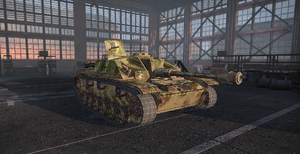
The lengthened 7.5 cm StuK 40 L/48 was standardized with the introduction of the F/8 - an Ausf. F built on the superior Panzer III J/L hull with thickened rear armor.
StuG III Ausf. G[ | ]
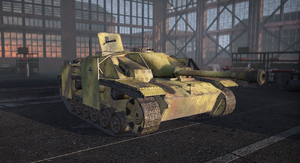
The Ausf. G was the final StuG III model produced from December 1942 onwards, boasting an improved superstructure design and the addition of side-mounted Schürzen for protection against anti-tank rifles and shaped charge weapons. Late G versions mounted the Topfblende pot mantlet, which provided increased protection for the gun, giving it the distinctive pig's head (Saukopf) shape.
- StuG III G (SD2): The basic variant.
- StuG III G Oberloskamp: A tank ace, representing Lieutenant Walther Oberloskamp.
- T.A.
- StuG III G Füh.: A platoon commander's tank.
Sturmi[ | ]
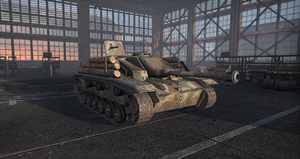
The Assault Gun Battalion replaced their BT-42 with StuG III. Finland ordered 40 but only received 30. The MG-34 on the top of the assault gun was replaced with a DT machine gun. Finland modified the armored protection. These StuG III were the only Finland modern Armored vehicle to see combat.
- Sturmi: The basic variant.
- Sturmi (Kpääl): A platoon commander's tank.
Sturmhaubitze 42[ | ]
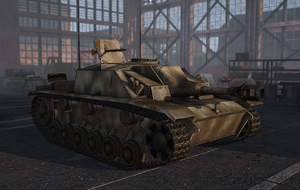
A StuH 42.
A variant of the StuG Ausf. F, Sturmhaubitze 42 (Sd.Kfz. 142/2) was introduced in 1942. Equipped with a 105mm howitzer, this new vehicle was designed to provide fire support for infantry, with StuG III Ausf. F/8 and Gs transitioning to an anti-tank role. Production models used StuG III Ausf. G chassis, with 1,299 produced by Alkett between 1943 and 1945.
